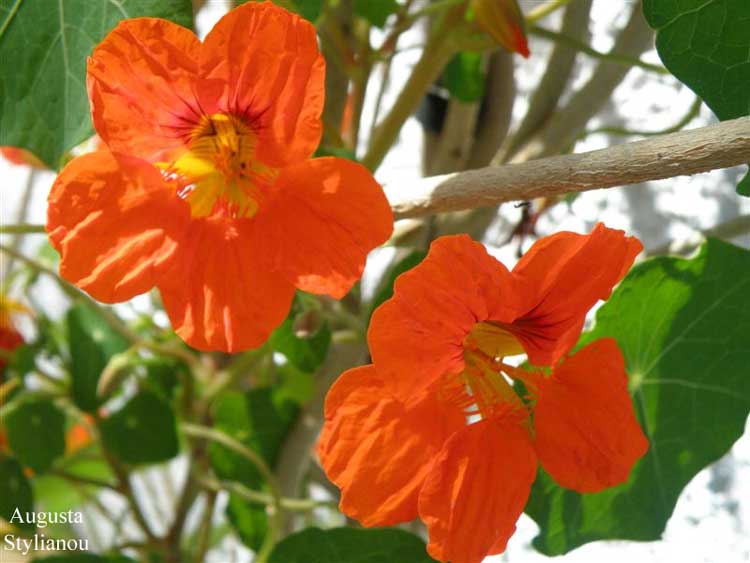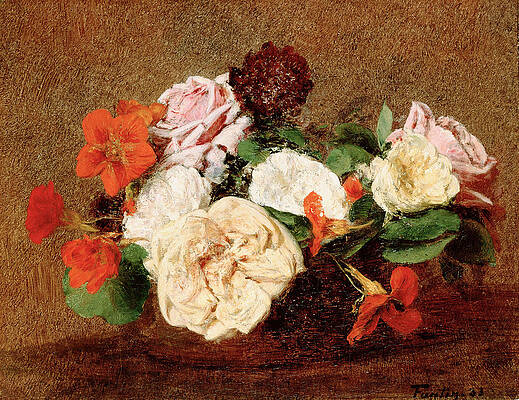
Tropaeolum majus, Photo: Augusta Stylianou Artist
Classification System: APG IV
Superregnum: Eukaryota
Regnum: Plantae
Cladus: Angiosperms
Cladus: Eudicots
Cladus: Core eudicots
Cladus: Rosids
Cladus: Eurosids II
Ordo: Brassicales
Familia: Tropaeolaceae
Genus: Tropaeolum
Sectio: T. sect. Tropaeolum
Species: Tropaeolum majus
Name
Tropaeolum majus L. (1753)
Synonyms
Homotypic
Cardamindum majus (L.) Moench, Methodus 20. 1802.
Tropaeolum elatum Salisb., Prodr. Stirp. Chap. Allerton 275. 1796, nom. superfl.
Trophaeum majus (L.) Kuntze, Revis. Gen. Pl. 1: 97. 1891.
Heterotypic
Tropaeolum hortense Sparre, Grana Palynol. 8(1): 110. 1968, nom. inval.
Tropaeolum hybridum L., Mant. Pl. 64. 1767.
Tropaeolum majus venustum Paxt., Paxton's Mag. Bot. 1: 193. 1836.
Tropaeolum majus f. atropurpureum hort.
Tropaeolum majus f. heinemannii hort.
Tropaeolum majus f. hemisphericum hort.
Tropaeolum majus f. regelianum hort.
Tropaeolum majus var. atropurpureum anon., Opera Bot.
Tropaeolum majus var. atrosanguineum Sweet, Brit. Fl. Gard., ser. 2, 3: t. 204.
Tropaeolum majus var. flore-pleno hort.
Tropaeolum majus var. nanum hort.
Tropaeolum majus var. regelianum hort.
Tropaeolum pinnatum Andrews, Bot. Repos. 8: tab. 535. 1808.
Tropaeolum quinquelobum Bergius, Kongl. Vetensk. Acad. Handl. 33. t. 1. 1765.
Trophaeum pinnatum (Andrews), Kongl. Vetensk. Acad. Handl. (1765) 33. t. 1. Kuntze, Revis. Gen. Pl. 1: 97. 1891.
References
Linnaeus, C. 1753. Species Plantarum 1: 345.
USDA, ARS, Germplasm Resources Information Network. Tropaeolum majus in the Germplasm Resources Information Network (GRIN), U.S. Department of Agriculture Agricultural Research Service. Accessed: 09-Oct-10.
Vernacular names
čeština: lichořeřišnice větší
dansk: Tallerkensmækker
Deutsch: Große Kapuzinerkresse
English: Garden Nasturtium, Indian Cress, Monks Cress
español: Capuchina, Espuela de Galán, Flor de la Sangre, Llagas de Cristo, Marañuela, Mastuerzo de Indias, Pelón
eesti: suur mungalill
suomi: Isoköynnöskrassi, köynnöskrassi
français: grande capucine
hrvatski: veliki dragoljub
magyar: Kerti sarkantyúka
íslenska: Skjaldflétta
italiano: nasturzio
日本語: キンレンカ
lietuvių: didžioji nasturtė
македонски: Лазибубе
Nederlands: oost-Indische Kers
polski: nasturcja Większa
română: Condurul doamnei, Caneluța, Conduraș
русский: Настурция майская, Капуцин большой
slovenčina: kapucínka väčšia
српски / srpski: Драгољуб
svenska: Indiankrasse
Türkçe: Latin çiçeği
українська: Красоля велика
中文: 旱金莲
Tropaeolum majus, the garden nasturtium, nasturtium,[3] Indian cress or monks cress, is a species of flowering plant in the family Tropaeolaceae, originating in the Andes from Bolivia north to Colombia. An easily-grown annual or short-lived perennial[4] with disc-shaped leaves and brilliant orange or red flowers, it is of cultivated, probably hybrid origin.[5] It is not closely related to the genus Nasturtium (which includes watercress).
Etymology
The species was originally called Nasturtium indicum ("Indian nasturtium") but the plant is not related to the true Nasturtium genus.
The current genus name Tropaeolum, coined by Linnaeus, means "little trophy". Tropaeolum is the diminutive form of the Latin tropaeum, itself borrowed from Ancient Greek τρόπαιον : trópaion "trophy".
The Latin specific epithet majus means “larger” (the neuter form of major).[6]
Description
It is a fast-growing plant, with trailing stems growing to 0.9–1.8 m (3–6 ft). The leaves are large, nearly circular, 3 to 15 cm (1 to 6 in) in diameter, green to glaucous green above, paler below; they are peltate, with the 5–30 cm long petiole near the middle of the leaf, with several veins radiating to the smoothly rounded or slightly lobed margin.
Lotus effect
Nasturtium leaves, like some other species, demonstrate the lotus effect, whereby rainwater falling on the surface gathers into globular droplets which roll off the leaf, leaving it dry and clean.[7] Electron microscope scanning reveals tiny bundles of waxy particles which repel the water.
Flowers and fruit
The flowers are 2.5–6 cm in diameter, with five petals, eight stamens, and a 2.5–3 cm long nectar spur at the rear; they vary from yellow to orange to red, frilled and often darker at the base of the petals. The fruit is 2 cm broad, three-segmented, each segment with a single large seed 1–1.5 cm long.[8][9]
The Elizabeth Linnaeus phenomenon
Das Elisabeth Linné-Phänomen, or the Elizabeth Linnæus Phenomenon, is the name given to the phenomenon of "flashing flowers".[10] Especially at dusk, the orange flowers may appear to emit small "flashes". Once believed to be an electrical phenomenon, it is today thought to be an optical reaction in the human eye caused by the contrast between the orange flowers and the surrounding green. The phenomenon is named after Elisabeth Christina von Linné, one of Carl Linnaeus's daughters, who discovered it at age 19.[11]
Ecology
The garden nasturtium is used as a food plant by the larvae of some Lepidoptera species including the dot moth[12] and the garden carpet moth.[13] A common pest found on nasturtiums is the caterpillar of the large white or cabbage white butterfly.[14]
Introduced range
The species has become naturalized in parts of the United States (California, New York, Pennsylvania, New Hampshire, Massachusetts, Connecticut and Virginia),[15][16] as well as parts of Europe, such as Gibraltar,[17] and Asia, Africa and Australia.[15] It is listed as invasive in Hawaii and Lord Howe Island, Australia.[9]
Cultivation and uses
Roses and Nasturtiums in a Vase by Henri Fantin-Latour
Yellow Nasturtiums, George Hitchcock
Tropaeolum majus cultivars are widely grown as easy annual plants, for poor, damp soil in full sun. The large seeds are easy to handle individually.
As they do not tolerate heavy frost they are best sown under glass in heat, and planted out after all danger of frost has passed. Alternatively, as they are fast-growing, they may be sown in situ in May or June.
Many flower colours are available, in the warm spectrum from cream through yellow, orange, red and maroon. Some have highly decorative marbling on the leaves.
The groups Whirlybird Series[18] and Alaska Series[19] have gained the Royal Horticultural Society’s Award of Garden Merit.[20]
Culinary
Salad with flowers and leaves
All of the above-ground parts of the plants are edible.[21] The flower has most often been consumed, making for an especially ornamental salad ingredient; it has a slightly peppery taste reminiscent of watercress, and is also used in stir fry. The flowers contain about 130 mg vitamin C per 100 g (3+1⁄2 oz),[22] about the same amount as is contained in parsley.[23] Moreover, they contain up to 45 mg of lutein per 100 g,[24] which is the highest amount found in any edible plant. The unripe seed pods can be harvested and dropped into spiced vinegar to produce a condiment and garnish, sometimes used in place of capers.[25]
Traditional medicine
Some native South Americans used the plant medicinally, apparently due to its antibiotic and antibacterial properties.[26] Some Europeans ate it to treat urinary and genital infections.[26]
Gallery
Botanical scan
Some color varieties
Flowering yellow and red
Flower showing nectar spur
Underside of leaf showing petiole attachment
Flower cut through to show structure
Immature fruit
Lobed leaf morphology
References
Tropicos
The Plant List
"Tropaeolum majus". Germplasm Resources Information Network (GRIN). Agricultural Research Service (ARS), United States Department of Agriculture (USDA).
"Tropaeolum majus". Pacific Island Ecosystems at Risk. Institute of Pacific Islands Forestry. 11 July 2013. Retrieved 2021-06-22.
Huxley, A., ed. (1992). New RHS Dictionary of Gardening. Macmillan ISBN 0-333-47494-5.
Harrison, Lorraine (2012). RHS Latin for Gardeners. United Kingdom: Mitchell Beazley. ISBN 978-1845337315.
"Scientific Image - Water Droplet on a Nasturtium Leaf". NISE (National informal stem education network). Retrieved 23 June 2021.
Jepson Flora: Tropaeolum majus
Pacific Island Ecosystems at Risk: Tropaeolum majus
H. W. "Das Elisabeth Linné-Phänomen (sogenanntes Blitzen der Blüten) und seine Deutungen", Nature (nature.com). Retrieved 4 May 2013.
"Försenad jätteplantering till Malmös schlagerfest, expert varnar för kalkning och kogödsel på påse", Odla med P1, Sveriges Radio, 29 April 2013. Retrieved 4 May 2013. (in Swedish)
"Dot Moth - Melanchra persicariae". Recording the wildlife of Leicestershire and Rutland. NatureSpot. Retrieved 2012-06-21.
Plymley, Katherine. "Garden Carpet Moth and Caterpillar Xanthorhoe fluctuata, Nasturtium". Shrewsbury Museums Service. Retrieved 2012-06-21.
"Cabbage caterpillars". Royal Horticultural Society. 2011-02-22. Retrieved 2012-06-21.
Flora of North America v 7 p 166
"Plants Profile for Tropaeolum majus (nasturtium)". plants.usda.gov. Retrieved 2018-03-07.
"Dicots | Flora of Gibraltar". floraofgibraltar.myspecies.info. Retrieved 2018-03-07.
"RHS Plantfinder - Tropaeolum majus Whirlybird Series". Retrieved 26 December 2018.
"RHS Plantfinder - Tropaeolum majus Alaska Series". Retrieved 26 December 2018.
"AGM Plants - Ornamental" (PDF). Royal Horticultural Society. July 2017. p. 103. Retrieved 26 December 2018.
Nyerges, Christopher (2016). Foraging Wild Edible Plants of North America: More than 150 Delicious Recipes Using Nature's Edibles. Rowman & Littlefield. p. 124. ISBN 978-1-4930-1499-6.
"Tropaeolum minus". Plants For A Future. Retrieved 2012-06-05.
United States Department of Agriculture Research Service (2010). "USDA National Nutrient Database for Standard Reference, Release 23". Nutrient Data Laboratory.
Niizu, P.Y. & Rodriguez-Amaya, Delia B. (2005). "Flowers and Leaves of Tropaeolum majus L. as Rich Sources of Lutein". Journal of Food Science. 70 (9): S605–S609. doi:10.1111/j.1365-2621.2005.tb08336.x. ISSN 1750-3841.
Owen, Marion. "Poor Man's Capers: How to make gourmet capers from nasturtium seed pods". Retrieved 2012-06-24.
Lyle, Katie Letcher (2010) [2004]. The Complete Guide to Edible Wild Plants, Mushrooms, Fruits, and Nuts: How to Find, Identify, and Cook Them (2nd ed.). Guilford, CN: FalconGuides. p. 130. ISBN 978-1-59921-887-8. OCLC 560560606.
Retrieved from "http://en.wikipedia.org/"
All text is available under the terms of the GNU Free Documentation License



